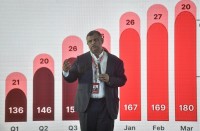SYDNEY, Australia (AFP) — Australia’s central bank held interest rates at a record low 1.50 percent Tuesday after annual inflation moved back into its target range, as it treads water ahead of the federal budget next week.
The Reserve Bank of Australia slashed 300 basis points from borrowing costs between November 2011 and August last year to support non-resources industries as the economy transitions out of a mining investment boom. It has remained on hold since then.
Headline inflation moving back into its 2-3 percent target band in the March quarter for the first time since 2014 was widely seen as reducing pressure to cut again.
But with household debt levels soaring due to an overheating property market, coupled with low wages growth and unemployment stuck at 5.9 percent, the bank is also reluctant to hike.
Consumer prices rose 0.5 percent in the March quarter, taking the annual rate to 2.1 percent, data showed last week. This was up from 1.5 percent in October-December, but slightly below forecast.
In a statement, Reserve Bank governor Philip Lowe said holding fire was “consistent with sustainable growth in the economy and achieving the inflation target over time”.
The decision to stay on hold was widely expected by economists ahead of the May 9 budget, which is tipped to include measures to address housing affordability and boost infrastructure spending.
The Australian dollar rose slightly after the central bank decision, from 75.37 US cents to 75.51 cents.
Lowe said the economy was continuing its transition following the end of the mining investment boom, “with the drag from the decline in mining investment coming to an end and exports of resources picking up”.
“Growth in consumption is expected to remain moderate and broadly in line with incomes. Non-mining investment remains low as a share of GDP and a stronger pick-up would be welcome,” he added.
The governor noted that employment was expected to grow and the unemployment rate decline “gradually over time”. Wage growth remained slow and was likely to stay that way “for a while yet”.
On housing, the bank said debt levels were growing faster than income but tougher regulatory measures targeting lending standards “should help address the risks associated with high and rising levels of indebtedness”.
© Agence France-Presse







